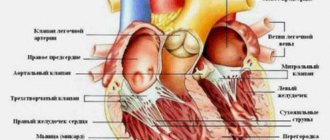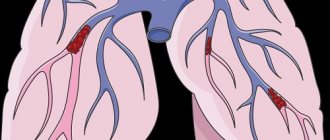Vertebral artery syndrome (VAS) is not a separate disease. It can be observed in a number of different pathologies, in which there is a narrowing of the lumen of one or two vertebral arteries, deformation of the walls and irritation of the nerves located nearby. As a result, the blood supply to certain parts of the brain is disrupted, which leads to a deterioration in their performance, sometimes to the point of critical conditions. In such situations, patients may suffer from persistent migraines, various visual and hearing impairments, loss of consciousness or a stroke. As a result, irreversible changes in the brain can occur, which can result in disability or even death.
Vertebral artery syndrome is a collective term that can be used to describe the clinical picture of many diseases that are fundamentally different in the cause of development, including cervical migraine or Barre-Lieu syndrome, arterial hypoplasia, vertebrobasilar insufficiency, provoked by cervical osteochondrosis, etc.
Vertebral artery compression syndrome is included in the International Classification of Diseases (ICD-10), where it is assigned code G99.2. This allowed doctors to widely use this term when describing a number of diseases and at the same time gave rise to lively discussions in medical circles about the advisability of its use when making a diagnosis, since SPA is nothing more than a complex of symptoms, and the causes of its occurrence can be very diverse.
Anatomy of the vertebrobasilar region and the mechanism of development of SPA
Two vertebral arteries originate in the upper part of the chest, pass through the lumen of the 6th cervical vertebra and rise strictly vertically through similar natural openings in the overlying cervical vertebrae. In the area of the occipital opening they merge into a single vessel called the basilar artery.
Therefore, vertebral artery syndrome can occur both against the background of the development of systemic vascular pathologies, and as a result of damage to the anatomical structures surrounding these blood vessels, i.e. connective tissue formations, muscles, nerves, vertebrae.
The two vertebral arteries and the basilar artery form the vertebrobasilar basin. They provide 15-30% of the blood supply to the brain. These arteries are responsible for the blood supply:
- the spinal cord passing at the level of the cervical spine;
- cerebellum;
- inner ear;
- posterior lobes of the thalamus and hypothalamus;
- midbrain and medulla oblongata;
- certain parts of the temporal and occipital lobes of the brain.
Therefore, if blood flow in the vertebral arteries is disrupted, regardless of the causes and location of the narrowing or blockage of their lumen, the listed parts of the spinal cord and brain experience a deficiency of oxygen and nutrients. This leads to the appearance of manifestations characteristic of SPA in the form of dizziness, pain of varying degrees of intensity, tinnitus, impaired coordination of movements, loss of consciousness, etc.
During vertebral artery syndrome there are 2 stages:
- Functional or dystonic - the initial stage of the development of SPA, at which the emerging manifestations of circulatory disorders mainly consist of the appearance of headaches of a burning, aching or pulsating nature, dizziness, unsteadiness of gait, visual disturbances in the form of darkening in the eyes, signs of photopsia. Most often, such symptoms are paroxysmal in nature and appear when the head is held in a forced position for a long time or there is a sudden movement. If this is accompanied by strong and prolonged spasms of the arteries, the disease leads to the formation of persistent foci of cerebral ischemia, which indicates the transition of SPA to the second stage of development.
- Organic or ischemic - accompanied by the occurrence of persistent disturbances in the blood supply to brain tissue, which leads to severe headaches, dizziness, reflexively causing nausea and vomiting, as well as serious disturbances in coordination, orientation in space, speech and other severe disorders. With a sudden movement, a person may suddenly fall while in the creation or lose it. An improvement in the condition is observed after taking a horizontal position.
Photopsia is a condition in which bright spots, spots, and sparks appear before the eyes.
Causes of development of vertebral artery syndrome
SPA can occur against the background of a large number of diseases. All of them can be divided into 3 groups: congenital anomalies, vascular pathologies and vertebrogenic (spine-related) disorders. But in all cases, either compression of the blood vessels (stenosis) occurs by one or another anatomical structure or a decrease in their lumen, which leads to disruption of blood flow through them.
Most often, the vertebral arteries are compressed in the area of 5-6 cervical vertebrae, as they most often suffer from osteochondrosis, protrusions, intervertebral hernias, and spondylosis.
Most often, vertebral artery syndrome is a consequence of:
- Osteochondrosis of the cervical spine and its complications in the form of protrusions and herniations of intervertebral discs, as well as spondylosis. In such situations, a decrease in the height of the intervertebral discs is observed, which leads to disturbances in the anatomy of the spine and compression of one or both vertebral arteries by the approaching vertebrae or by bone outgrowths (osteophytes) formed on their edges.
- Pathological mobility of the cervical vertebrae, basilar impression, subluxation of the articular processes of the vertebrae, Powers and Kimmerly anomalies. In such cases, the vertebral arteries are displaced or compressed by spasmodic muscle fibers or abnormally located bone structures.
- Compression of the spinal roots. This is accompanied by reflex arterial stasis, i.e. stopping blood flow.
- Thrombosis and atherosclerosis of the vertebral arteries. These vascular pathologies lead to a narrowing of the lumen of the arteries as a result of the formation of blood clots or atherosclerotic plaques, the size of which directly affects the quality of blood flow. In some cases, the blood passage can be so weakened or completely blocked that a stroke results.
- Benign and malignant tumors located in close proximity to the vertebral arteries. They are also capable of mechanically compressing vessels and leading to corresponding circulatory disorders in the vertebrobasilar region.
In most cases, the left vertebral artery is affected, since it is in it that atherosclerotic plaques most often form, and developmental anomalies are more often observed on the left side.
Also, the reason for the development of SPA can be:
- fibromuscular dysplasia;
- tortuosity and the presence of kinks of the vertebral arteries;
- hypertension;
- systemic vasculitis;
- myofascial syndrome;
- scoliosis;
- spondylolisthesis, etc.
Lifestyle change
For a full course of treatment, doctors recommend changing your attitude towards familiar things:
- reduce salt intake with food;
- if necessary, quit smoking and lose weight;
- adjust your work and rest schedule, get enough sleep;
- if there is a high level of cholesterol in the blood, you need to reduce the amount of fat consumed;
- be less nervous, and if stressful situations develop, use sedatives;
- To relieve pain, it is recommended to wear a Chance collar at home, and, if possible, at work, which reduces the load on the cervical spine.
Types of SPA
Depending on what caused the disruption of blood flow in the vertebral arteries, there are 4 forms of SPA:
- compression – occurs when the arteries are mechanically pinched;
- irritative - is a consequence of spasm of the muscle fibers of the arterial walls, which is observed when the nerve fibers innervating it are irritated;
- angiospastic - develops when irritation of receptors located at the level of the affected spinal motion segment of the cervical spine and is also accompanied by reflex vascular spasm;
- mixed – the action of several factors is observed.
Most often, patients are diagnosed with mixed forms of vertebral artery syndrome, namely compression-irritative and reflex-angiospastic.
In this case, vertebral artery syndrome can occur in completely different ways. Based on this, several of its clinical forms are identified, described below.
Barre-Lieu syndrome
This syndrome is also called cervical migraine. Its main manifestation is headache, which occurs in the cervical-occipital region. It tends to quickly spread to the parietal, occipital and frontal parts of the head.
Most often, the pain is shooting, throbbing or constantly present. Mostly they occur in the morning immediately after waking up and are associated with an uncomfortable head position during sleep. They may also appear or intensify during running, fast walking, strong vibrations, for example, during a bumpy ride, or sudden turns of the head.
With Barré-Lieu syndrome, patients may suffer from autonomic disorders, i.e., the appearance of a feeling of heat, chills, a sudden increase in sweating, difficulty swallowing, etc. Also, headaches may be accompanied by difficulties in maintaining body balance and visual impairment.
Basilar migraine
With this form of vertebral artery syndrome in patients, the clinical picture is dominated by migraines, accompanied by:
- bilateral visual impairment;
- severe dizziness;
- impaired coordination of movements while maintaining normal muscle tone;
- tinnitus;
- speech disorders.
During an attack, pain is most acutely felt in the back of the head and often provokes reflex irritation of the vomiting center of the brain. Sometimes the pain can become so severe that the person loses consciousness.
Basilar migraine is a consequence of impaired blood flow in the basilar artery, formed by the fusion of two vertebral arteries.
Vestibulo-atactic syndrome
This form of SPA is manifested by the presence of:
- dizziness;
- imbalance, which leads to a feeling of decreased stability;
- nausea or vomiting;
- darkening of the eyes;
- a feeling of disturbances in the functioning of the cardiovascular system.
These symptoms tend to intensify after a long stay in an uncomfortable position or with sudden movement of the neck.
Cochleo-vestibular syndrome
In this form, the clinical picture of vertebral artery syndrome is dominated by hearing impairment. Patients may experience difficulty recognizing whispers and general hearing impairment. They often complain of tinnitus, the intensity of which depends on the position of the head.
Hearing impairment is confirmed by instrumental diagnostic methods, in particular an audiogram.
Often, hearing impairment in cochleo-vestibular syndrome is accompanied by the occurrence of facial paresthesia, i.e., a decrease in the sensitivity of the facial skin, the appearance of a crawling sensation, and tingling. During an attack, a person may sway, lose a sense of stability, and may feel dizzy.
Ophthalmic syndrome
Visual impairment mainly consists of the appearance of photopsia, increased eye fatigue and deterioration in vision clarity while reading or working at the computer. Often there are signs of conjunctivitis, as well as loss of entire fields of vision, especially in certain positions of the head.
Ischemic attacks
In case of circulatory disorders in the vertebrobasilar system, ischemic attacks can occur, which occur:
- short-term sensory and motor disorders;
- speech disorders;
- partial or complete loss of vision;
- dizziness;
- nausea, vomiting;
- swallowing disorders;
- impaired coordination of movements.
Drop attacks
A drop attack is a causeless fall, often with preservation of the creation, which is caused by a sharp cutoff of blood flow to the brain. They are often observed when the head is thrown back and are caused by sudden paralysis of the limbs. But the restoration of motor function usually occurs quickly.
Manifestations of vertebral artery syndrome
Thus, the main symptoms of vertebral artery syndrome are:
- headaches, mainly concentrated in the back of the head and forehead;
- pain in the neck that occurs and intensifies when moving the head or maintaining a certain position for a long time;
- dizziness, which may be accompanied by disturbances in balance and coordination of movements;
- hearing and vision impairments;
- ischemic attacks with the occurrence of speech, sensory, motor and other disorders.
Which signs of vertebral artery syndrome will be more pronounced and which will be weaker depend on the form of the vertebral artery syndrome. There may also be additional symptoms of concomitant diseases, which complicates the diagnosis.
Exercise therapy
Exercise therapy for vertebral artery syndrome is an effective method of eliminating the main pathological symptoms, the effectiveness of which is based on strengthening the muscular structures of the neck, which create a framework for the neurovascular bundle. With the help of special therapeutic exercises, it is possible to achieve a positive effect of therapy and prevent complications of the process. The doctor will tell the patient in more detail about the duration and scope of such treatment after studying the clinic’s problem, the extent of the disorders and the presence of complications.
Diagnostics
Diagnosis of SPA is carried out by a neurologist. The specialist needs to be able to identify the patient’s main complaints and compare them with the characteristics of each form of the disease. If the existing symptoms correspond to the clinical form of SPA, it is important to diagnose the causes of its development, i.e., to detect which vascular or spinal pathologies led to impaired blood flow through the vertebral arteries.
To this end, the doctor initially conducts a thorough examination and neurological tests, which allow one to suspect what could have caused the SPA. To confirm guesses, obtain more accurate information and detect possible concomitant diseases, the patient is prescribed:
- X-ray or CT scan of the cervical spine;
- MRI of the cervical spine;
- Ultrasound of neck vessels with Doppler sonography;
- stabilometry;
- general and biochemical blood test;
- audiometry, etc.
In our clinic, you can also learn in more detail about the composition of your body and the state of the vascular system, which is involved in the blood supply to internal organs, skeletal muscles, and the brain. Our experienced doctors will explain the data obtained to you in detail. Bioimpendansometry calculates the ratio of fat, muscle, bone and skeletal mass, total fluid in the body, and basal metabolic rate. The intensity of recommended physical activity depends on the state of muscle mass. Metabolic processes, in turn, affect the body's ability to recover. Based on the indicators of active cell mass, one can judge the level of physical activity and nutritional balance. This simple and quick test helps us identify disturbances in the endocrine system and take the necessary measures. In addition, it is also very important for us to know the condition of blood vessels for the prevention of diseases such as heart attacks, hypertension, heart failure, diabetes and much more. Angioscan allows you to determine such important indicators as the biological age of blood vessels, their stiffness, stress index (which indicates heart rate), and blood oxygen saturation. Such screening will be useful for men and women over 30, athletes, those undergoing long-term and severe treatment, as well as everyone who monitors their health.
Often, for the correct diagnosis of vertebral artery syndrome and the causes of its development, consultations with other specialized specialists, including cardiologists, ENT specialists, ophthalmologists, etc. are required.
Today, SPA is often falsely diagnosed, which is due to the insufficient completeness of the examination.
Physiotherapy
Physiotherapeutic treatment helps eliminate many problems with impaired blood flow through the vessels that supply the brain. In such pathological conditions, a specialist can decide on the advisability of prescribing UHF therapy, electrophoresis, mud applications, magnetic therapy, etc. to the patient. These modern techniques can improve the nutrition of the central nervous system, eliminate the manifestations of the disease, normalize blood flow, reduce tissue swelling and relieve local inflammation. Before physiotherapeutic treatment, you should consult a doctor. For more detailed information, you can follow the link.
Treatment of vertebral artery syndrome
After confirming the presence of RAS and determining the reasons for its development, a treatment regimen is individually developed for each patient, taking into account the variant of the course of the disease. The main goals of therapy are to improve blood flow through the vertebral arteries and eliminate factors predisposing to its deterioration.
In most cases, treatment of vertebral artery syndrome is carried out at home. Only with frequent ischemic attacks is hospitalization recommended for patients, since in such cases there is a high risk of stroke.
Patients are prescribed:
- drug therapy;
- manual therapy;
- physiotherapy;
- Exercise therapy.
Sometimes surgical intervention is required to effectively eliminate factors compressing the vertebral arteries. But modern treatment methods in most cases make it possible to achieve stable remission of the disease, eliminate all its manifestations and normalize the patient’s quality of life. But this is only possible with timely diagnosis of the causes of the development of SPA and competent influence on them in compliance with all recommendations received from the doctor.
Drug therapy
Patients are prescribed a whole range of drugs that help normalize blood flow in the vertebrobasilar region.
- drugs that improve blood flow;
- NSAIDs;
- purine derivatives;
- α-blockers;
- calcium antagonists;
- cholinergics;
- neuroprotectors;
- cardiac drugs;
- muscle relaxants;
- antispasmodics;
- antimigraine drugs;
- vitamins.
Treatment of atherosclerosis, thrombosis, osteochondrosis and other detected concomitant diseases is also mandatory.
Manual therapy
Manual therapy is very effective in the treatment of spas. With the help of special soft techniques, stretching the neck muscles and restoring the correct position of the vertebrae, in some cases it is possible to completely eliminate the causes of compression of the vertebral arteries and normalize the blood flow in them.
Using the Gritsenko method to combat the manifestations of vertebral artery stenosis also allows you to normalize muscle tone and achieve effective restoration of intervertebral discs, as well as activate the body’s natural recovery processes.
Using special techniques, compression of the spinal roots and nerve fibers is eliminated, which quickly leads to the elimination of pain and neurological disorders in the form of disorders of sensitivity, mobility, etc. Moreover, the method is almost completely free of contraindications and the risk of side effects. Therefore, it can be used to treat patients even from special categories such as pregnant women and the elderly.
Physiotherapy
Physiotherapeutic treatment is also widely prescribed for SPA. It is used to normalize vascular tone, activate blood circulation and metabolism, and also have a positive effect on the central nervous system.
For vertebral artery syndrome, the following physiotherapeutic procedures are indicated:
- magnetic therapy;
- electrophoresis;
- UHF;
- ultraphonophoresis;
- Diadynamic therapy.
Exercise therapy
An individually selected set of exercises will help normalize blood flow, as well as relieve muscle spasms and strengthen weakened neck muscles. But in no case should you choose a complex of physical therapy on your own, since with certain features of vertebral artery stenosis, performing a series of head movements can lead to a sharp shortage of blood in the brain. All exercises recommended by a specialist should be performed smoothly, without sudden movements and with a large amplitude.
Thus, the development of vertebral artery syndrome should be regarded as an important signal from the body, signaling the occurrence of serious disturbances in its functioning. Therefore, when symptoms of SPA appear, it is necessary to make an appointment with a neurologist as soon as possible and undergo a comprehensive examination in order to detect the causes of its development. This will help to detect emerging diseases in a timely manner and carry out treatment appropriate to the situation, which will prevent the progression of existing pathologies and the occurrence of dangerous complications of vertebral artery syndrome in the form of stroke and death.
5 2 votes
Article rating
Massage
It is prescribed starting from the subacute period of the disease. Its main goal is to relax tense neck muscles, which will help reduce compression (squeezing) of the vertebral arteries.
Unprofessional implementation of massage techniques can lead to the development of very serious and life-threatening complications: pulmonary embolism, complete compression of neck vessels with the development of syncope, or even stroke.







